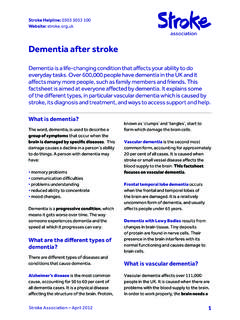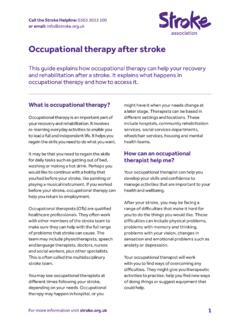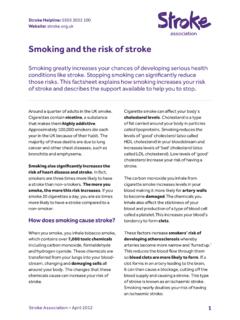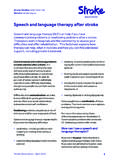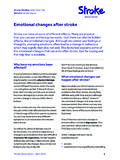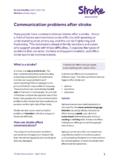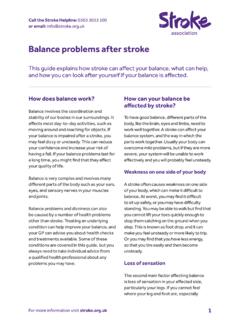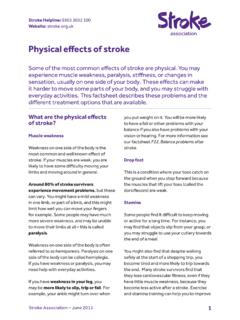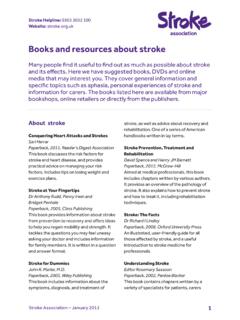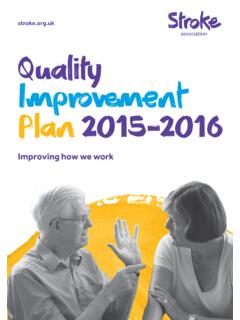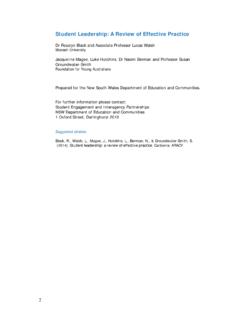Transcription of stroke.org.uk State of the Nation - Stroke Association
1 Of the NationStroke statistics January 2016 Together we can conquer stroke2 State of the Nation Stroke statistics - January 2016 Contents3 Glossary4 Key statisticsWhat is Stroke ? 6 Clots and bleeds7 What is a transient ischaemic attack (TIA)? Stroke epidemiology 9 How often does Stroke strike?10 Age11 Social deprivation12 Ethnicity 13 Childhood stroke14 Stroke survivors15 Effects of stroke16 Feeling overwhelmed17 MortalityStroke risk factors and prevention 20 High blood pressure21 Diabetes22 Atrial fibrillation23 Patent foramen ovale24 Other risk factors25 Smoking, alcohol and drug use26 PreventionStroke treatment 28 Stroke pathway29 Thrombolysis30 What happens when you go home?31 Disability32 Rehabilitation33 The cost of stroke34 Short-changed by stroke35 Research spend in the UK References 36 References1.
2 Glossary3 State of the Nation Stroke statistics - January 2016 Aphasia: Aphasia (sometimes called dysphasia) is a language disorder caused by Stroke . It can affect speech, comprehension and reading and writing skills. Hyper-acute Stroke unit: Specialist centres to manage the first 72 hours of Stroke care. Onset: When the symptoms of Stroke first started. Also referred to medically as ictus . Thrombolysis: A clot-busting treatment to dissolve the clot and restore blood flow. Also referred to as rt-PA and alteplase . Door to needle: The time it takes from admission to hospital (door) to administering thrombolysis treatment (needle). Early supported discharge (ESD): Designed for Stroke survivors with mild to moderate disability who can be discharged home from hospital sooner to receive the necessary therapy at home.
3 Ischaemic Stroke : A Stroke caused by a clot. Haemorrhagic Stroke : A Stroke caused by a bleed. Transient ischaemic attack (TIA): Sometimes referred to as a mini- Stroke or warning Stroke an event is defined as a TIA if the symptoms resolve within 24 hours. ABCD2 score: ABCD2 is predictive tool used to assess the short-term risk of Stroke after a TIA. Incidence: The number of Stroke occurrences. Prevalence: The number of living Stroke survivors. Mortality: The number of deaths caused by Stroke . Epidemiology: The study and research of how often a disease occurs in people and of the Nation Stroke statistics - January 2016 Stroke kills twice as many women as breast cancer and more men than prostate and testicular cancer combined a year.
4 Black people are twice as likely to have a Stroke compared to white people. Black and South Asian people have strokes at a younger age compared to white people. Stroke is one of the largest causes of disability half of all Stroke survivors have a disability. Over a third of Stroke survivors in the UK are dependent on others, of those 1 in 5 are cared for by family and/or friends. For every cancer patient living in the UK, 241 is spent each year on medical research, compared with just 48 a year for every Stroke patient. Stroke occurs approximately 152,000 times a year in the UK; that is one every 3 minutes 27 seconds. First-time incidence of Stroke occurs almost 17 million times a year worldwide; one every two seconds. There are over million Stroke survivors in the UK.
5 3 in 10 Stroke survivors will go on to have a recurrent Stroke or TIA. 1 in 8 strokes are fatal within the first 30 days. 1 in 4 strokes are fatal within a year. Stroke is the fourth single largest cause of death in the UK and second in the world. By the age of 75, 1 in 5 women and 1 in 6 men will have a Key statistics5 State of the Nation Stroke statistics - January 2016 What is Stroke ?6 State of the Nation Stroke statistics - January 2016 There are two types of strokes ischaemic (clot) and haemorrhagic (bleed). About 85% of all strokes are ischaemic and 15% 23. Clots and bleedsIschaemic strokes are caused by a blockage cutting off the blood supply to the brain. The blockage can be caused by a blood clot forming in an artery leading to the brain or within one of the small vessels deep inside the strokes are caused when a blood vessel bursts within or on the surface of the brain.
6 Because the blood leaks out into the brain tissue at high pressure, the damage caused can be greater than the damage caused by strokes due to a are two types of haemorrhagic Stroke :1. Intracerebral haemorrhage (ICH) bleeding within the brain2. Subarachnoid haemorrhage (SAH) bleeding on the surface of the brain. Haemorrhagic strokes are generally more severe and are associated with a considerably higher risk of mortality within three months and beyond, when compared to ischaemic 4 10 15% of people affected with SAH die before reaching hospital and 25% die within 24 Without treatment 25 30% will re-bleed within the first four weeks 70% of these people will die as a strokes are usually classified into five different categories:31. Large-artery atherosclerosis a clot from the arteries2.
7 Cardioembolism a clot from the heart3. Small-vessel occlusion a narrowing and weakening of blood vessels4. Stroke of other determined etiologies5. Stroke of undetermined etiology. It is not unusual for strokes to be of an undetermined cause. Strokes of undetermined etiology and small-vessel occlusion are usually associated with better life expectancy than strokes of other Strokes due to cardioembolism a clot from the heart are usually the most devastating type of ischaemic of the Nation Stroke statistics - January 2016 ABCD2 score is used to predict the short-term risk of a Stroke after a TIA: A = Age B = Blood pressure C = Clinical symptoms D = Duration of symptoms D = Diabetes. 1 in 12 people will have a Stroke within a week of having a TIA.
8 Approximately 10,000 recurrent strokes can be prevented every year in the UK if TIA and minor strokes are treated in A transient ischaemic attack, or TIA (often referred to as mini- Stroke or warning Stroke ) is where Stroke symptoms resolve within 24 hours. A TIA should be treated just as seriously as a full Stroke . 46,000 people in the UK have a first incidence of TIA every Approximately 15% of ischaemic strokes are preceded by a The greatest risk of Stroke is within the days immediately after a TIA. a4. What is a transient ischaemic attack ( TIA)?Risk of Stroke following a TIA:8 95% at 48 hours8% at one week12% at one month17% at three monthsScore PointsAny score four and above is HIGH RISK and should be seen at a specialist TIA clinic within 24 hoursAny score three and under is LOW RISK and should be seen at a specialist TIA clinic within 7 daysABCD2 after a TIAAge 60> Yes +1BP > 140/90 mmHg at initial evaluation Yes +1 Clinical features of the TIA.
9 Unilateral weakness +2 Speech disturbance without weakness +1 Duration of symptoms? 10-59 mins +1 Over 60 mins +2 Diabetes mellitus in patient s history? Yes +1 8 State of the Nation Stroke statistics - January 2016 Stroke epidemiology9 State of the Nation Stroke statistics - January 2016 CountryStrokes per year in menStrokes per year in womenStrokes per year overallEngland (2007)1157,48868,457125,945 Scotland (2009)116,5327,83014,362 Wales (14/15)153,6023,8207,422 Northern Ireland (13/14)162,2092,2074,416 United Kingdom69,83182,314152,145 Stroke occurs approximately 152,000 times a year in the That is one Stroke every 3 minutes and 27 seconds in the UK.
10 Incidence rates in the UK vary depending on the country or region being researched. It can range from 115 per 100,000 population to 150 per 100,000 population depending on the 13 Stroke incidence rates fell 19% from 1990 to 2010 in the Men are at a 25% higher risk of having a Stroke and at a younger age compared to 14 However, as women live longer there are more total incidences of Stroke in women. The greatest risk of recurrent Stroke is in the first 30 days. Every two seconds someone in the world will have a Stroke for the first time. There were almost 17 million incidences of first-time Stroke worldwide in How often does Stroke strike?Approximately 30% of Stroke survivors will experience a recurrent Stroke or studies State between 25% and 33% of all strokes are recurrent 18 19 2010 State of the Nation Stroke statistics - January 2016 Age is the single most important risk factor for Stroke .
